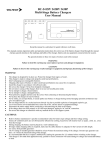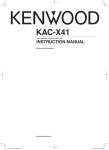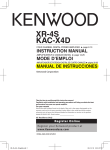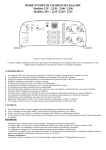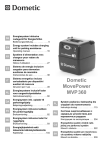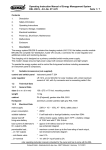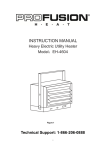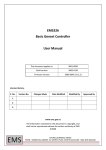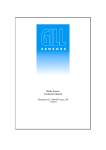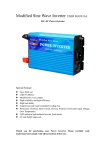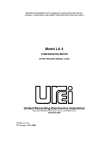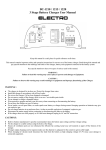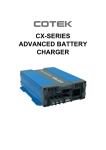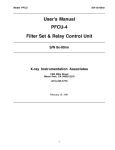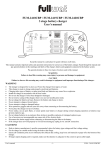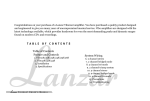Download BC-1240P-1AP April 2014 Manual
Transcript
BC-1240P-1AP 12V 40A Multi-Stage Battery Chargers User Manual Keep this manual in a safe place for quick reference at all times. This manual contains important safety and operation instructions for correct use of the battery charger. Read through the manual And pay special attention to the markings and labels of the charger, battery and any equipment connected into the system. Pay special attention to these two types of notices used in this manual; WARNING: Failure to heed this warning may cause injury to persons and damage to Equipment. CAUTION: Failure to observe this warning may result in damage to equipment and improper functioning of the Charger. WARNING: ● ● ● ● ● ● ● ● ● ● ● ● ● ● ● ● ● The charger is designed for in-door use. Protect the charger from ingress of water. This charger is made to charge only properly sized lead acid batteries. Don't recharging non-rechargeable batteries. Charging other types of battery or under-sized lead acid batteries may cause fire or explosion. Install the charger in accordance with all local codes Do not use the charger if it has been dropped or damaged. Do not remove casing of the charger, there is no user serviceable parts inside. Never attempt to charge a frozen battery Never attempt to charge a damaged battery. Wear protective goggles and turn your face away when connecting or disconnecting the battery. Never place the charger on top of a battery. Never smoke, use an open flame, or create sparks near battery or charger during normal charging operation as Batteries may give out explosive gas. Do not charge batteries in a sealed enclosure (boxed- in) due to possible explosion of entrapped explosive gas. Use of accessories not recommended may cause risk of fire, electric shock or equipment damage. Disconnect the mains supply before connecting or disconnecting the links to the battery. If the charger does not work properly or if it has been damaged, unplug its AC and DC connection. Do not use this charger in connection with any medical device or life support system. CAUTIONS: ● ● ● ● ● ● ● Refer to battery manufacturer’s specific recommended values for battery type settings and float voltage setting. Ensure all ventilation ports are not obstructed for efficient fan cooling, keep loose soft material such as paper, cloth, etc. away from the Charger During charging, the battery must be placed in a well ventilated area. If longer output charging cable are required, make sure the cable diameter is adequate for the Current & Cable length. AC source from portable generator: The VA rating of standard generator should be at least 4 times the maximum rating of the charger. Inverter type generator can have 2 to 3 times the maximum rating of the charger. It is recommended that the ac output is stabilized by running the generator for 2-3 minutes before switching on the charger. This charger is for stand alone application only, parallel or series connection will cause damage to charger and connected battery or load. Introduction Congratulations on purchasing our new Multi-Stage (IU0U) Switching Mode Battery Charger. This series of advanced chargers use Micro-Processor to control the charging profiles and protective functions. The special charging programs are designed to charge both stand alone battery and battery with connected loads. Innovative charging profiles blend in with the ever changing “state of charge” of the batteries to give just the right amount of current and voltage so your batteries will not be under or over charged. There are 8 sets of selectable charging profiles specifically designed for a wide range of Wet, Gel, AGM, LiFePO4 and Calcium-Calcium lead acid batteries. There are two user programmable charging profiles for the professional users through USB port by personal computer. In addition, the programmed maintenance charge provides a timely Equalization charge for the Wet lead acid battery and refreshing charge to the sealed batteries. Almost all the protections are controlled by the Micro-Processor. On start-up, the charger run a series of self-tests on the protective functions, displays and critical components like the cooling fan. The optional detachable Remote Control Panel provides exceptional monitoring of the batteries, charger output, protection status, hours of operation and etc. Intended Use: All Automotive, Marine, Mobile Home, Electric Scooters, Golf Carts, Solar, Deep Cycle, UPS Standby, Industrial & Commercial Applications. A. Control and Indicators 1. Power Switch To turn ON and OFF AC power to charger 2. Charger status LED display Charger ON LED (Green) Bulk LED (Red) Absorption LED (Orange) Float LED (Green) Over Temp LED (Red) Fault LED (Red) : : : : : Lights up when power ON Bulk charging with Constant Current (max.) Absorption charging with preset Constant Voltage Float charging with preset Constant Voltage Lights up when over temperature protection, Flashing when current de-rating : Charger malfunction (overload, output short circuit, reverse polarity, output over voltage protection) 3. Programming Port Factory use only 4. Battery selection switch For AGM, GEL, LiFePO4, Calcium-Calcium, 2x user define & WET (Flooded) batteries (default at GEL P-1) 5. Charging current selection switch Current can be selected from 10% to 100%. Details please see the table on front panel. (Default at 100%) 6. USB port Connect charger to a computer for utilizing ‘User define setting’ or Data logging upload [See Sec. P] 7. Remote display Port Connect to accessory HBR-3100 remote display To remote display the charging voltage & charging status and remote control the charger output ON/OFF & Equalization. 8. Equalization mode selection switch Can be selected by Manual or Auto 9. Battery Connection/ DC Output Terminal(s) [Note; BC-1240P1-AP = 50Amp Grey Connector] 10. Ventilation Fan 11. Inlet AC socket with Mains fuse holder 12. Temperature Sensor Socket Connection to Battery Temperature sensor (accessory) Sensor to increase / decrease charging voltage at low/ high battery temperature B. Using the charger 1. Check the supplied accessories: AC cord, Remote Battery temperature sensor, CD (software) & USB cable are with the package. [BC-1240P1-AP model also includes a matching Grey 50 Amp connector kit.] 2. Remove the magnetic dummy remote control panel on the front of the charger to select the battery type and the max. output (charging) current, you may need to ply it open to get a hold the edge of the panel in order to lift it out . 3. Battery Type Selection Check against the Absorption and Float Voltage with the battery type and specifications given in section N. Make sure the charger is power OFF. Use a small slot type screw driver to select the battery through Battery Selection Switch (4). AGM/GEL : Sealed type (VRLA), AGM-GEL, Maintenance Free, Automotive or Deep Cycle lead acid batteries WET : Flooded Type lead acid batteries (to which water can be added) Automotive or Deep Cycle Calcium-Calcium : Sealed type (VRLA) Lead Acid batteries with Calcium content Automotive or Deep Cycle LiFePO4 : Sealed type Lithium Iron Phosphate batteries The selected battery type can be viewed at the optional remote panel. 4. Warning; ONLY Calcium-Calcium type batteries are to be charged in this mode and only when a boost charge is required (15.1Volts). No load is to be connected to the battery during this charge mode. Charge through one cycle only then set the battery selector back to The WET setting. C. Power Level adjustment End users can Preset the maximum output (charging) current in 10% increments to make the charger suitable for different Battery capacities &/or loading conditions. Make sure the Main Switch is OFF before adjust the power level. Use a small slot type screw driver to select the maximum output current via the Charging Current Selection Switch (5). The selected max. output current can be viewed on the optional remote panel . Position 0: 40 Amp Position 9: 36 Amp Position 8: 32 Amp Position 7: 28 Amp Position 6: 24 Amp Position 5: 20 Amp Position 4: 16 Amp Position 3: 12 Amp Position 2: 8 Amp Position 1: 4 Amp Recommended Battery Capacity 15AH to 400AH The extended range of 15 to 400 AH capacity is based on the appropriate charging current selection 10% to 100%. Some battery type can take higher charge current. When in doubt check with battery manufacturer for recommended charging current. D. Testing the charger with output open circuit (nothing connected to the output terminal) On power up, the charger will do a self check during which all the LED indicators are on and fan in full speed for a few seconds. Then the Charger On and the Absorption LED are on if charger is checked out OK. After 5 minute the Float LED will be on and Absorption LED off. Remark: You can connect a load to the output terminal and the charger will provide a constant DC source voltage according to the ‘Battery type’ and available ‘Output power’ (current) settings selected, (as detailed in Sections B3 and C.) This feature is handy for caravan installer to check the operation of connected powered appliance or connections. E. Battery Charger Installation and Connection Observe the warnings & safety precautions before rushing to install and operate the charger. Check battery condition, fill up cells for wet battery, clean battery poles. Secure the battery charger in a well ventilated place, make sure the mounting surface is flat and without soft covering material or loose paper sheet. The air intake is at the bottom and air outlet at the back. Make sure both intake and outlet are not blocked. Never place charger on top of battery. Plug in the AC mains and turn on Power Switch. All the indicators on the front panel will lit up, cooling fan spins at full speed for 10 seconds by means of Self-Testing. After self-test mode the Charger ON LED and either Bulk LED or Absorption LED will be lit initially (depending on the state of the battery). After 5 minutes, if the battery is in a high state of charge, the charger float LED will be lit, otherwise the charger can stay in either Bulk Or Absorption mode for longer periods if needed. Before connecting or disconnecting the charging cable, turn off the Power Switch and unplug AC cord from the mains. First connect the Battery Chargers Positive (+) terminal to the Battery Positive (+) Post. Then connect the Chargers Negative (–) terminal to the Battery Negative (–) Post. For BC-1240P1-AP Model; Connect the Grey 50Amp connector to the Chargers corresponding Connector (9) then connect The Battery Positive (+) followed by the Battery Negative (-). Make sure all the connections are clean, secured and tight. Double check for correct polarity. Double check again for correct selection of Battery Selection Switch (4) for battery type (default at GEL P-1) and Charging Current Selection Switch (5) for output current setting (default at 100%) When installed in caravans and similar vehicles, the connection to the supply mains is to be in accordance with national wiring rules. When charging automotive batteries: - The battery terminal not connected to the chassis has to be connected first. The other connection is to be made to the chassis, remote from the battery and fuel line. The battery charger is then to be connected to the supply mains; - After charging, disconnect the battery charger from the supply mains. Then remove the chassis connection and then the battery connection. F. Normal 4-Stage (IUoU) Charging Operation The 4-stage IUOU charge algorithm ensures fast, complete and at the same time gentle charging of the lead acid battery. Charging Profile Stage 1. THE I-PHASE. The constant current charging, Bulk LED is ON. Normally the battery is charged at constant maximum current until it rises to the selected Absorption voltage level. The charging voltage changes with the battery voltage. Soft-Start Bulk Charging: If at the initial bulk charging, the battery voltage is at less than 12.3V, the bulk charge current is reduced to half of the maximum until battery voltage rises to 12.8V. This soft start charging is set for 10 minutes and will repeat until battery voltage rises to 12.8V. At the end of 2 hours battery voltage cannot reach 12.8V, alarm will sound and output is cut off. Remark: If the battery keeps the charger at Bulk mode for 12 hours, the charger will automatically switch to Float mode. Stage 2. THE UO-PHASE. The constant voltage charging, Absorption LED is ON. Battery Type Selection: Gel P-1: 14.1V / Gel P-2: 14.3V/ AGM: 14.3V / LiFePO4: 14.6V/ Wet: 14.4V / Calcium: 15.1V When the battery voltage reaches the selected Absorption voltage level, the charging switches to Constant voltage charging (Absorption stage). Charging current will decrease gradually until a pre-set value at which the charger then automatically switches to Float Stage. The max. Absorption time is also controlled by the time in Bulk charge , and battery type selected . Stage 3. THE UO-PHASE. The constant voltage charging, Float LED is ON. In Float stage, the battery is full and only takes in the amount of current necessary for maintaining the capacity. The float voltage is preset according to the type of battery selected by the user. Battery Select Switch (4). If the charger stays in this mode with charging current less than 5A for over 72 hours. Then the charger will automatically Switch into the Standby mode. Stage 4. THE UO-PHASE. The constant voltage charging, Float LED is ON. In Standby stage, The charging voltage at this mode will be 4% less than the Float voltage only for maintaining the capacity. This lower charging voltage level reduces drying out of electrolyte liquid, prolongs the life of an inactive battery. New Cycle Charge every 21 days The Charger will start a new charging cycle of Bulk to Absorption to Float every 21 days in either standby or float mode. This new cycle of charging will refresh the battery to prevent separation of the electrolyte & keep the electrode plates in good condition. This automatic New Cycle charge after 21 days is designed to keep the battery in good working condition during long periods of storage of the Caravan/RV or back up battery applications. Remark: Charger can give out full selected max current in Float or Standby mode. If battery voltage drops to 12.5V for approx. 10 minutes in Float or Standby mode: The charger will start a new cycle of charging. G. STORAGE If the RV/ etc. is in storage for an extended period of time and no solar panels are available to charge the battery, To help guard against Self-discharge of the Battery; • Leave the AC power connected & the Battery Charger turned on. First ENSURE ALL loads are turned OFF or Dis-connected from the Battery. The charger has an automatic Standby Charge Mode and a 21 day New Cycle charge to take care of the battery in storage. • Or disconnect the Battery charger from the vehicle battery if the AC Mains is to be disconnected or turned off. Warning; Batteries on charge should not be left unattended for extended periods. The charging process & battery condition should be checked regularly. H. User Define Charging Profiles Connect the charger to a personal computer through USB port (6) then you can set your own charging configuration. There are two charging positions allocated to store the preset algorithm’s by the user. (Battery Selection Switch (4) set to position 7 or 8.) I. Equalization Charging for wet type battery only Warning: Explosion Hazard Explosive gases from battery during equalization, extreme care must be exercised. Caution: Only flooded lead acid battery which must have one complete charge cycle before equalization charge. Make sure electrolyte level is sufficient. Disconnect all DC load connected to the battery Exercise extreme care to comply with the above cautions when Auto-Equalization is selected. Wet lead acid batteries requires periodic higher voltage charging (about 10% over usual absorption voltage) to balance the Voltage of each cell, reverse the high concentration of electrolyte at the bottom and clear up large sulfate crystals on the plates. You can use the Equalization Selection Switch (8) to perform the manual equalization through optional remote display or Auto equalization by charger itself. Once Auto it is selected, the charger will start Equalization automatically if charger keeps at Float mode for over 21 days. After entered into this mode, the Absorption indicator will flash. This will put the charger keep Equalization for 240 minutes. The charger will go to Float once completed. Remark: 1. This mode only can be operated at Flooded battery selected (Battery Selection Switch (4) set to positions 1, 9 or 0) 2. During this mode, operator can press the FUNC button (optional remote display) for 5 seconds to force the charger to Float mode anytime. 3. Take special precautions as battery will emit explosive gas during equalization charge. J. Temperature Sensor Warning: The temperature sensor must be installed at the Negative Terminal of the battery terminal, In-correctly connecting to the Positive Terminal will damage the charger and the sensor. The temperature sensor (accessory) is used for optimal charging over a wide ambient temperature range. The Temperature sensor should be positioned so as not to be affected by any other cooling or heating source. Plug in the temperature sensor before switching on the charger to activate the temperature control function, Never plug in the Sensor during charging. Compensation voltage for this temperature sensor is 20mV/C, the higher the battery temperature, the lower the charging voltage. When battery temperature reaches 60°C, the charger will shutdown, Fault and OTP indicator will light up. K. Cable Size Selection Wire Size (AWG) Area (mm2) 10 8 6 4 2 1/0 2/0 4/0 Maximum one-way distance (feet) for 2% Voltage loss (30A) 3.8 6 9.5 15 24 38 48 76 5.26 8.37 13.3 21.2 33.6 53.5 67.4 107 Maximum one-way distance (feet) for 2% Voltage loss (40A) 2.8 4.5 7.2 11.2 18 27.5 36 58 Maximum one-way distance (feet) for 2% Voltage loss (60A) 1.6 2.5 3.6 6.8 11 17.7 22 34 Table: Selection of cable size and length versus current L. Fault Indications PROTECTIONS & FAULT INDICATIONS WITH CAUSES PROTECTION / FAULT FAULT LED OTP LED CHARGER OUTPU: OFF= No Output REMOTE CONTROL UNIT & LCD Fault Display Output power decreases due to high operating ambient temperature OFF Flashing ON At reduced power in 25% step leading no specific indication for high to output off high temperature protection temperature decreased output see next row charger over heat, OTP protection on Solid ON Solid ON OFF Manual power on off reset after fault Alarm flash & Buzzer on “Charger cleared High Temp” Charger preset to reduced output OFF power OFF ON At reduced output power as selected Indicates “xx% Power Set” Battery over heat detected by remote temp sensor at (60°C) Flashing Solid ON OFF Manual power on off reset after fault Alarm flash & Buzzer on “Bat Over cleared Temp” Fan not working or stuck Flashing Flashing OFF Manual power on off reset after fault Alarm flash & Buzzer on “Fan Fault” cleared Output Over Voltage Protection when output voltage is 4% Solid ON higher than it should be for the battery type and charge stage OFF OFF Manual power on off reset after fault Alarm flash & Buzzer on “Output V cleared High” Overload/ Over Current Protection when output current is 10% higher than the rated maximum level Solid ON OFF OFF Manual power on off reset after fault Alarm flash & Buzzer on “Overload” To protect charger cleared Short Circuit for > 20 sec Solid ON OFF OFF Manual power on off reset after fault Alarm flash & Buzzer on “Output cleared Shorted” Short Circuit for < 20 sec OFF OFF ON Charger returns to normal after fault cleared Reverse Polarity Protection (Thermal Fuse) Solid ON OFF OFF Manual Power on off reset after correct fuse replaced Alarm flash & Buzzer on “WRONG POLARITY” REMARKS Auto return to full set power gradually as unit temp cools down This is not a fault!! So no specific indication To protect battery and load connected. M. Trouble Shooting PROBLEM INDICATIONS POSSIBLE CAUSES SUGGESTED SOLUTION Charger does not work Indicator lights not turn on No AC power Check AC connections are correct AC input socket fuse blown Replace with correct AC fuse by qualified electrician No DC output Charger - On LED is Output short circuit not on, Float and Fault LEDs are on Battery does not get All indicator LED full charge work normally and sequentially Check DC connections between charger and battery. Charger can auto reset if remove the fault within 20 seconds. Over temperature protection triggered Check air intake vent at bottom of charger is blocked or not. Check charger ambient ventilation. Severe over loading charger Check battery AH capacity within recommended range Reverse polarity connection Check for correct polarity, replace car blade fuse (6) DC fan locked by foreign object or malfunction Check DC fan Bad battery connection Check for loose contact, right cable size, cable integrity Battery type select switch in wrong setting Recheck battery type and change to correct battery selection Battery capacity too large Make sure charger rating matches battery capacity Ambient temperature too low Move battery to a room temperature location, or get an optional temperature sensor Battery has damaged cell or battery is too old Replace battery Wrong set the lower power level Recheck the current selection switch (5) to correct right setting Long charging time, Absorption light float light does not remains on all the come on even after time 12 hours charging time. Charger internal fault Return the charger to distributor to repair Bulk LED is on all the time Wrong battery type selection Check charged battery label and change battery type selection to correct setting Battery is excessively depleted and the soft charging is triggered Recharge the battery after a day, if bulk light remains after several hours, the battery is most likely damaged and cannot accept charge. Replace battery. Battery temperature too high Use accessory temperature sensor OTP LED flashing Bulk light remains on all the time N. Specifications Model Output BC-1240P-1AP Output (Charge) Voltage Selections Absorption Float WET 14.4V 13.5V LiFePO4 14.6V 13.6V AGM 14.3V 13.2V GEL 1 14.1V 13.7V GEL 2 14.3V 13.8V CALCIUM 15.1V 13.8V User Define 1 12V - 16V User Define 2 12V - 16V Equalization 15.5V Maximum Output Charging Current (Continuous) 40A Recommended Battery Capacity Range 15 – 400AH Soft Start Bulk Charge Battery Voltage to Trigger (cut-in) Soft Start Bulk Charge Mode <12.3V Soft Start Bulk Charge Current (Current Limit) 1/2 of the charging current Ripple and Noise (Peak to Peak) <200mV Efficiency at Maximum Power (230V) >83% Dual Bank Charging (Battery must be of same type) Yes AC Voltage Range 200 – 240V 50Hz~ AC Current at Full Load (230V) 3.5A Overload 90-110% Rated Output Current or 50% Rated Output Current (Soft Charge) Protection Type: Constant Current Limiting, recovers Automatically after Fault Condition is Removed. Short Circuit Recovers Automatically if Fault Condition is Removed within 20 seconds Otherwise the charger will shutdown until re-start the charger again Reverse Polarity Car Blade Fuse Over Temperature Protection Type: Shut Down OVP Output Over Voltage Yes Cooling Method Thermostatic, Variable Speed Fan 4-Stage Battery Charger Yes Charge Phase Bulk / Absorption / Float Yes Fault Mode Yes Over Temp Yes Charger ON Yes AC Fuses at IEC AC Power Socket T4A slow blow DC Car Blade Fuse at Front Panel 30Ax2 Supplied Accessories Remote Temperature sensor, ac cable, spare ac fuse at socket, one set of 50 Amp Grey Connector Kit. Optional Accessory Remote Control Panel (Model:HBR-3100) Safety : CE: EN 60335 SAA: AS/NZS 60335.1, AS/NZS 60335.2.29 (Include clause 21.102 : vibration Test) Yes EMC: CE EN 55014; EMF: EN50366 Yes Others Dimensions and Weight 200x80x260mm ; 3.2kg Remarks All values are based on the standard ambient temperature 25°C and pressure 0.1Mpa. Input Protection Cooling Indicators Fuses Accessories Approvals O. Optional Remote Display HBR-3100 Warning: AC mains supply must be disconnected completely from the battery charger before plugging in of the Remote Display HBR-3100. Otherwise the charger will be damaged. I. Introduction The Remote Display comes with 10m extension cable with interconnector. When the optional remote HBR-3100 is installed, it will display the real time charging stage, voltage & amperage, battery type set, max. power level set, type of fault with alarm, etc and can remote control the output terminal On/OFF, trigger the Equalization charging for wet battery and force charger to float mode. It can be mounted on BC charger by replacing the dummy cover on the front panel or remotely mounted with 10m extension cable going through the unplugged hole at the front of the dummy panel. II. Connection 1. 2. 3. 10 Meters Phone Cable In Line Coupler 6P6C HBR-3100 Remote Display Module a. Take out the dummy remote panel from charger and remove the black hole plug from the dummy remote panel. Hole plug b. Remote cable through the dummy remote panel’s hole. c. Plug in the remote cable into the charger remote socket. d. Mount back the dummy remote panel on the charger panel. III. Control and Indicator 1. Output ON/OFF : To switch the charger output ON and OFF. Green LED is illuminated when output is ON. 2. Alarm : Can be silenced or audible by toggling this button, default is audible. Red LED will illuminate when fault occurred 3. Func. : To toggle charger setting Menu and select scrolling to make display continue to scroll all setting (See optional remote programming section) 4. Set : To confirm the chosen feature you selected. IV. Programming using the optional remote A. B. Pressing Func. Button to display “Scrolling” or until any setting you want to display Pressing Set button to confirm Remote Panel “Scrolling” Menu Options 1. Charger Name Display charger model 2. Charger Status Display Bulk / Absorption / Float 3. Battery Type Display the battery type selected 4. Fault Display the “No Fault Found” or Type of fault 5. Bat. Bank 1 Display the charging voltage and current of Bank 1 6. Bat. Bank 2 Display the charging voltage and current of Bank 2 for other models in this series 7. Bat. Bank 3 Display N.A as no Bank 3 for this series of charger 8. Total Run Time Display units total run time 9. Output Power Level Display current output level 10. Software Version Displays the current control software version Remote Short cut 1. Press and hold the SET button for 5 seconds and release the button to enter Equalization mode. (Equalization selection slide switch on main unit should be selected at manual position) 2. Press and hold the Func. button for 5 seconds and release the button to force the charger to Float mode. V. Fault Indication 1. Charger High Temp 2. Bat Over Temp 3. Output V High 4. Overload 5. Output Shorted 6. Wrong Polarity 7. Fan Fault P. : : : : : : : Charger over temperature Battery temperature over 60°C as detected by remote sensor Output over voltage Overload (OCP) Output short circuit Output reverse polarity Fan stuck or not working HBC SOFTWARE INSTALLATION PLEASE REFER TO THE USER MANUAL IN THE CD FOR INSTALLATION AND APPLICATION PROCEDURE REV.4 04/2014 7673-3140-3529













